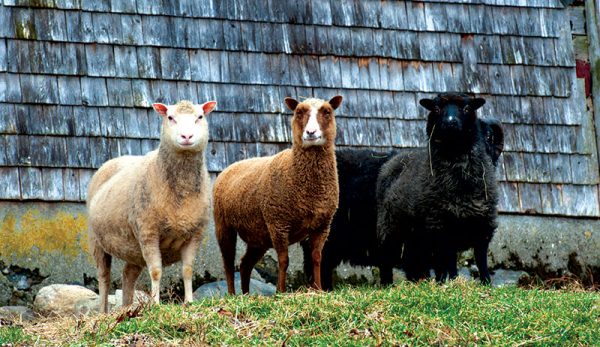
All breeds of livestock, including poultry, cattle, sheep, goats and hogs, were developed for specific purposes. This makes it easy to select breeds suited for the needs of you and your farm. We developed this guide to identify some great breeds for various jobs and situations.
Poultry Picks
Perfect Nonheritage Layer: Cinnamon Queen

Cinnamon Queens are top-notch hybrid layers with two notable attributes: They’re meaty enough to raise as tasty, tender fryers or broilers, and they’re autosexing—meaning the sexes are easily discernible directly from the egg. Cinnamon Queens are also nonbroody, so they don’t take timeouts to raise chicks. Pullets begin laying sooner than heritage breeds, producing 250 to 320 large to extra-large brown eggs a year. They’re calm, friendly birds and great free-rangers, but they adapt well
to henhouse living, too.
Perfect Heritage Layer: Hamburg
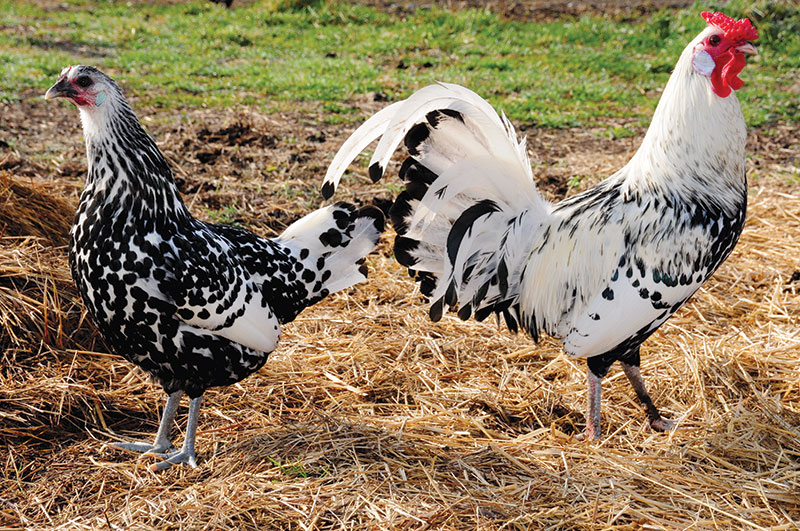
If you need lots of eggs but prefer heritage breeds, think Hamburgs. These small, sprightly birds are avid foragers and need room to roam; Hamburgs don’t fare well in confinement. They’re strong flyers, alert and flighty, but they make up for this by being prolific layers of small to medium white eggs, averaging 200 to 220 per year, even through the cold winter months. They come in an array of colors, in standard as well as bantam sizes. Hamburgs are listed in the Watch category of The Livestock Conservancy’s Conservation Priority List.
Big-time Broiler: Cornish Cross

If you want lots of meat, and you want it fast, try Cornish Crosses. Also known as Cornish Rocks, Cornish Xs and White Broilers, these huge, hybrid birds are ready for processing as fryers at 5 to 6 weeks of age and as meaty roasters by the time they’re 7 to 9 weeks old. However, their astoundingly rapid growth comes at a price. As they reach greater sizes, their legs can give out, they easily overheat and they’re somewhat prone to heart failure, so you shouldn’t keep them beyond slaughtering age for breeding or as barnyard pets.
Big-time Heritage Broiler: Buckeye

If you don’t mind slower-growing birds, Buckeyes are a better bet for hassle-free broilers. They are, however, one of the fastest-maturing heritage breeds, and their succulent, tasty meat is worth the wait. Buckeyes are easy-to-raise, cold-hardy, extremely laid-back birds that are foraging mavens, able to rustle up much of their summer fare. They have frostbite-resistant combs and adapt well to winter confinement. Hens are better than average layers, producing 120 to 250 large brown eggs per year, laying even through the coldest winter months. They come in standard and bantam varieties, and they’re listed in the Watch category of The Livestock Conservancy CPL.
No Ordinary Ornamental: Sultan

The critically endangered Sultan has more distinguishing features than any other breed, among them a V-shaped comb, a crest, a beard, muffs, feathered shanks and toes, and five toes on each foot. The Sultan is an ideal ornamental and exhibition chicken, and because it’s rare, raising Sultans helps preserve a classic breed. Sultans are famous for friendliness and ultra-calm dispositions, making them wonderful pets. Their recognized color is White with slate blue shanks and toes, though blue and black varieties occur. Sultans come in standard and bantam varieties and are listed in the Critical category of The Livestock Conservancy CPL.
One Nice Bird: Cochin
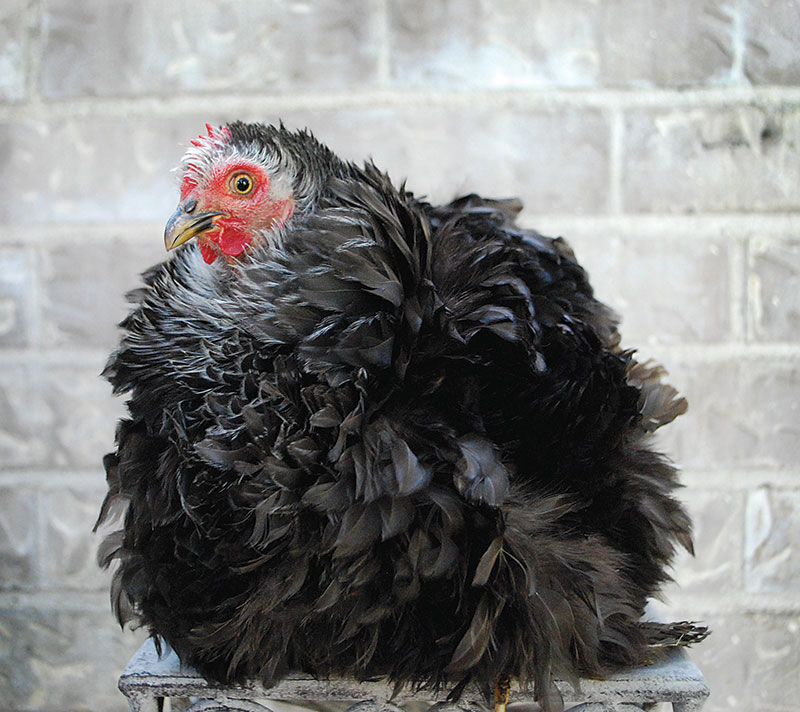
The cute, fluffy, feather-legged Cochin is an ancient breed with a huge modern following. It’s a calm, sweet and cuddly breed that makes a wonderful pet, but it’s also a decent layer of as many as 150 to 180 large brown eggs per year.
Standard Cochin roosters weigh around 11 pounds; hens, 8½ pounds: They’re truly big, but their soft plumage makes them look bigger still. Standard and bantam Cochins come in a wide range of color varieties including Buff, White, Black, Blue, Brown, Partridge, Silver Laced, Golden Laced and Barred. They also come in a frizzle variety, in which their cover feathers curve up and out. Cochins are listed in the Recovering category of The Livestock Conservancy CPL.
A Delightful Duck

Most domestic ducks are specialists: eggs or meat, you have to choose. Not so the easygoing Orpington, also known as the Buff Orpington duck, which lays 150 to 220 eggs per year and gains weight so quickly that it attains a meaty market weight of 6 to 7 pounds in just 8 to 10 weeks. A heritage breed, it was developed by the William Cook family who lived in the Orpington area of Kent, England, in the early 1900s and who also developed Orpington chickens. Orpington ducks are listed in the Threatened category of The Livestock Conservancy Conservation Priority List.
Small-Farm Sheep
Perfect Pet: Babydoll Southdown

The diminutive, original Babydoll version of the popular Southdown reflects the breed before it was selectively bred for extra height and weight. The Babydoll was imported into the U.S. and seen in England in the 1800s through the early 1900s. Around 1990, it was labeled Olde English Babydoll Southdown to differentiate it from the larger modern American Southdown.
Today, Babydolls are primarily kept as pets as well as orchard and vineyard weeders, but they also grow a nice, 2- to 4-inch, 27- to 34-micron fleece. Most Babydoll Southdowns come in creamy off-white, though black sheep are popular, too.
Marvelous Multipurpose Breed: Icelandic

The Icelandic is another fluke-tailed, triple-purpose sheep. It’s milky enough for home dairying, and it grows a lovely double fleece. An Icelandic fleece is composed of a 4- to 7-pound, 27- to 30-micron, 6- to 8-inch outer layer (called tog) and a 19- to 22-micron, 2- to 4-inch undercoat (thel). Producers often shear Icelandics twice a year. This breed is grown mostly for meat in Iceland. Here, grass-fed Icelandic lamb commands good prices. Icelandics come in a wide array of colors and marking patterns, making soft, cushy pelts a lucrative sideline for meat producers. Long-horned ram skulls fetch high prices, too.
Best Bet to Make a Sweater: Shetland
Like Icelandics, the Shetland is a primitive breed, fluke-tailed and double-coated and somewhat smaller than its northern kin. Shetland sheep are fine-boned and agile. Rams weigh just 90 to 125 pounds, and ewes weigh 75 to 100 pounds. They come in a wide variety of colors, markings and patterns—11 colors and 30 patterns in all. Its fleeces can vary in micron count from around 20 into the 30s. Double coats vary also; some are more pronounced while others appear to be single coat. Shetlands are friendly, hardy and easily managed, making them a fine choice for first-time and long-term shepherds.
Dairy Queens: East Friesian

This sheep has more than milk going for it. It is, indeed, a triple-purpose breed (milk, meat and wool). It hails from East Friesland in northern Germany and the Province of Friesland in the Netherlands, where it emerged as the most productive dairy sheep in the world, producing lactation milk yields of 1,100 to 1,700 pounds for mature ewes. East Frisians also produce an 8½- to 11-pound, 35- to 37-micron white fleece with an average 5-inch staple and two or three robust, meaty lambs each year. Both sexes are polled and have thin, wool-free fluke tails that don’t require docking.
Great Goats
A Milk Maven: Alpine

Some dairy goat breeds produce more milk while others give milk that’s higher in butterfat. The pretty French Alpine, however, is an all-around dairy queen, producing 1 to 1½ or more gallons of 3½ percent butterfat milk per day. Alpines are medium to large goats, smart and agile, and come in a variety of colors and markings. The Alpine breed is known for its extra-long lactation: This is not a goat that peters out after four or five months in milk. In fact, Alpines are noted for their ability to “milk through,” meaning many Alpines can be milked for years without being rebred, a boon for anyone needing fresh milk year-round.
A Choice for Cheese: Nigerian Dwarf

This small but mighty milk producer is no more than 22½ inches tall at the shoulder but produces 1 to 8 pounds of rich, 6 percent to 10 percent butterfat milk per day, compared with 2 to 6 percent butterfat in the milk of full-size dairy breeds. High butterfat content makes sweet, creamy, Nigerian Dwarf milk the perfect medium for crafting goat cheese. And because of their sunny dispositions and compact size, Nigerian Dwarfs are easier to house and handle than bigger goats.
A Meat Maven: Boer
South African Boer goats came to North America in the early 1990s. Since then, they’ve become America’s premier meat goat. Boers are good-natured and docile and come in a variety of colors including traditional (white with a red or black head), black, red, spotted and dappled. Boers have long, muscular bodies set on proportionally short legs and sturdy horns that sweep back from the head. Does generally give birth to two to four fast-maturing kids that are capable of gaining 1⁄2 pound per day (and more) through weaning at 3 months of age. Unlike the other meat goat registries, the organizations that register Boers sanction shows throughout the U.S., making Boers the goat of choice if you like to show.
Fine for Fiber: Colored Angora

This medium size, friendly, laid-back goat grows long, lustrous, wavy locks of mohair fleece as long as 12 inches. It comes in white and colored varieties. Colored Angoras come in several colors including black (ranging from coal black to silver), fading red and shades of brown. They are generally shorn twice a year when locks are 4 to
6 inches long. Colored Angora fiber is in especially high demand with fiber artists.
Good Bet for Brush-clearing: Spanish
Christopher Columbus brought Spanish goats to Haiti on his second voyage in 1493; numerous shipments of Spanish goats soon followed, and some were driven through Florida and onto Mississippi, Alabama and Georgia. Some of those goats escaped to become the feral goats of our American Southwest.
Spanish goats weigh between 50 and 200 pounds. They come in many colors, with multiple types of horns. They are tough, wary and hardy, making the breed America’s first choice among brush- and land-clearing goats. Critically endangered just a few decades ago, heritage Spanish goats are staging a dramatic comeback. They are listed in the Watch category of The Livestock Conservancy CPL.
Hogs
For the Small Farm: Kunekune

While many Americans consider Kunekunes pet pigs, the breed is also a first-class porker. It was introduced to New Zealand in the early 1800s, when the Maori people raised this little pig for meat. This hardy, good-natured pig is also a peerless forager, ideal for raising on pasture by families that prefer small cuts of tasty meat. It’s a compact, short-legged, short-bodied pig with a short, thick, upturned snout, wattles and small, upright ears. Because of their short, upturned snouts, Kunekunes are poor rooters, so they won’t ruin yards and pastures.
Best Bet for Bacon: Tamworth
The Tamworth is a long-legged, long-bodied, narrow pig with a thick, fine-textured coat, finely fringed, upright ears and a long, straight snout. An ancient bacon-type hog, it was established in Britain by the Middle Ages.
Tamworths are active, intelligent pigs that don’t adapt well to confinement. They are good-natured, extremely hardy and superb foragers that do exceptionally well in outdoor situations.
They thrive on pasture, acorns and other woodland browse; they are also vigorous rooters. Adults reach 600 to 800 pounds in two years while grower pigs reach slaughtering age at 5 or 6 months. Tamworths yield a lot of nicely marbled but lean meat, including scrumptious bacon.
Great for Pulled Pork: Berkshire
Noted for especially succulent, mouth-watering meat that is darker red in color than conventional pork, Berkshires are hardy and do well in indoor and outdoor situations. They are fast-maturing, good-natured, easy-to-manage hogs developed in the 1800s for a changing market with a preference for leaner cuts of pork. The American Berkshire Association, established in 1875, gives pedigrees only to pigs directly imported from established English herds or to those tracing directly back to imported animals.
Clearing Land Champ: Ossabaw Island Hog
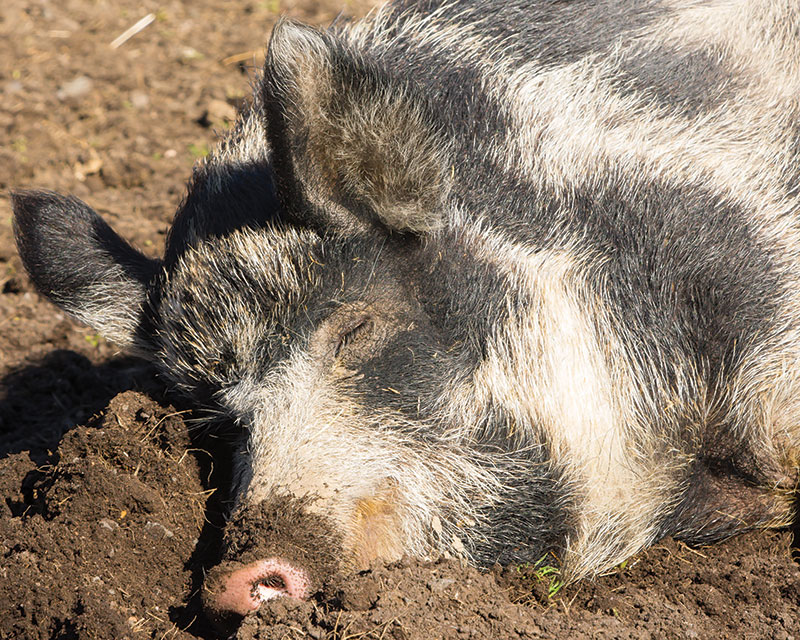
Small, feral-looking, heavy-coated and bristly, these pigs have long snouts, heavy shoulders and prick ears fringed with long hair. They descend from swine that Spanish explorers left off the coast of Georgia on Ossabaw Island almost 400 years ago. Ossabaw Island Hogs are hardy, self-sufficient pigs that like their own space. They produce smaller cuts of well-marbled, juicy meat, and for anyone wanting land cleared, long-snouted Ossabaw Island hogs are peerless rooters.
Crazy for Cattle
Great for Steaks: Miniature Hereford

These scaled-down versions of full-size Herefords measure 38 to 43 inches at the hip and weigh roughly half what standard Herefords weigh. They’re healthy and hardy and eat roughly 1⁄2 to 1⁄3 as much grass and feed as full-size Herefords. All the meat from a single steer will fit in an average freezer, so Miniature Herefords are just right for most families to feed, butcher and eat within the recommended freezer life of beef.
Most Distinct Appearance: Highland
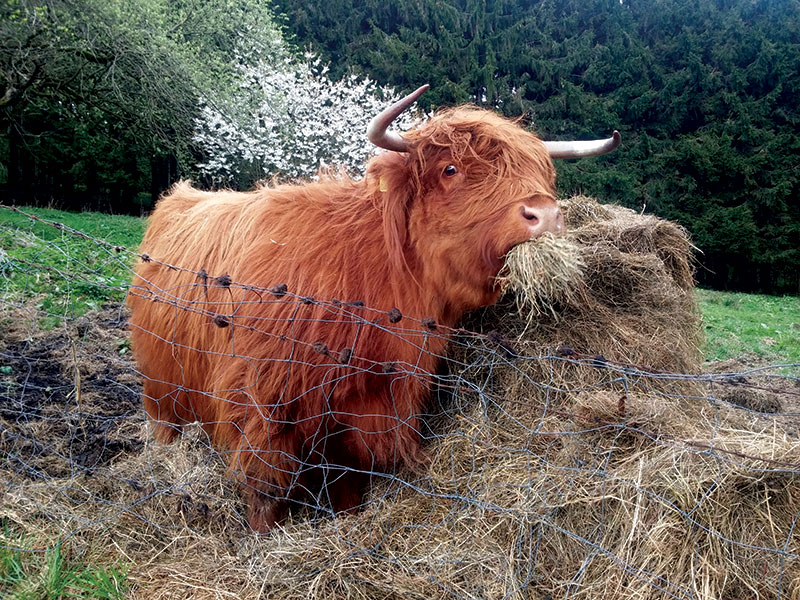
This ancient breed developed via natural selection in the rugged, mountainous areas of Scotland. Highlands are short, stocky, long-coated, long-horned cattle with a mop of shaggy hair that covers their eyes. They are also productive cattle, ideal for producing grass-fed beef. Highlands are small and compact, docile, extremely cold-hardy, and adaptable to any climate conditions, disease resistant and adaptable. Highland beef is lean, well-marbled and delicious, with little outside fat. Fiber artists cherish their downy winter undercoat for hand-spinning purposes. Highlands are listed in the Recovering category of The Livestock Conservancy CPL.
A Milking Maven: Jersey
The Jersey is one of the oldest and best dairy breeds as well as the smallest, with a mature size of about 1,000 pounds. Jerseys were brought to the U.S. in the 1850s. Jerseys of all sizes are fast-maturing, alert but gentle, people–oriented cows, and they’re also easy-keepers, qualities that make them first-class hobby farm family milk cows. The American Jersey Cattle Association states that compared with average milk, “a glass of Jersey milk has greater nutritional value: 15 percent to 20 percent more protein, 15 percent to 18 percent more calcium, and 10 percent to 12 percent more phosphorus, and also considerably higher levels of an essential vitamin, B12.”
The Miniature Jersey stands as tall as 42 inches (with mid Miniatures between 42 to 46; more than
46 equals breeding stock), weighing 600 to 650 pounds, and can give 2 to 2½ gallons of milk per day, with an average 4 percent butterfat.
Grazing Greats: Galloway & Belted Galloway

Galloway cattle originated in southwest Scotland near the English border, where they were documented as early as the 16th century. They were originally horned like Highland cattle, but Galloway breeders selected for hornlessness during the late 1700s. Today, all Galloways are polled.
They are hardy and easy going, excellent grazers, good mothers, and because of low birth weights, calving problems are rare. Their long, sometimes wavy, double winter coat makes them ideally suited for northern climates. Galloways come in three primary colors—black, red and dun—and in two color patterns—solid and white park. Belted Galloways evolved as a separate breed about 150 years ago as result of Galloway cattle being crossed with Dutch Belted cattle. Belted come in black, dun and red, all with a band of white around their middles.
Galloways are listed in the Watch category of The Livestock Conservancy CPL; Belteds are Recovering.
Whether you want to start raising livestock or add breeds to your small farm, do your research and choose a breed that fits your needs. If none of the breeds in this article quite fit what you’re after, search the Hobby Farms website to learn about additional breeds and how to raise them.
This story originally appeared in the November/December 2017 issue of Hobby Farms.




